Interior Design educators from across the US and Canada gathered at Columbia College Chicago for their 62nd annual meeting this spring. Attendess included fulltime and adjunct faculty (more than 290), students (about 175), professional organizations and industry partners. Like many conferences, there were keynotes, presentations/panels sessions, and poster sessions. But unlike most conferences the session and poster submissions were double blind peer reviewed, ensuring content that was rigorous and relevant to the interior design industry.
Defining the Term: Double Blind Peer Reviewed
A review process of abstracts for potential presentation at a conference whereby neither the authors nor the reviewers know one another’s identities, to reduce bias and evaluate solely on the merit of the work.
The Keynotes
The conference kicked off with two keynote speakers, Avinash Rajagopal/Editor in Chief – Metropolis and Kay Sargent/Sr. Principal and Director of Thought Leadership, Interiors – HOK and Work Design Contributor.
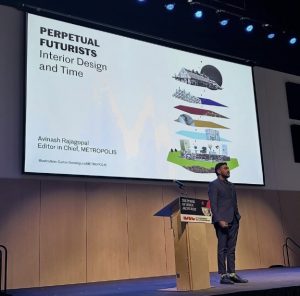
Rajagopal’s remarks were a call to action for interior designers to consider their work in the context of time. He expanded upon the “seven shearing layers,” originally developed by Frank Duffy. A building is “composed of layers that change at different rates… and evolve at their own pace influencing the overall longevity and adaptability of a building,” (Wiki, 2024). While the site is forever and a building may have a 60-200 year life span, the typical space plan has a serviceable life of about 5-20 years. As interior designers consider their practice, being a steward of each project is more sustainable than joining in the relay race to get things done as quickly and cheaply as possible.
Constant change in natural. Infinite growth is cancerous.
– Avinash Rajagopal
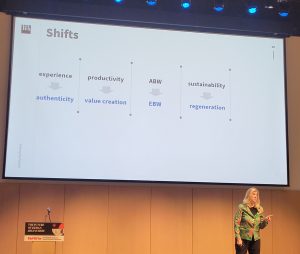
Sargent’s message explored the issues facing students today: staggering debt, continual retraining (potential jobs in 10 or even 5 years don’t exist yet), the need to be accessible 24/7 and the prospect of lower earnings than their parents. She called for a massive re-thinking of work including sabbaticals in all professions, a four-day work week and a reshaping of the real estate industry as we know it. The spaces we create have an intense impact on the people who use them. The next generation will be designing not only environments but also experiences.
The question for emerging interior designers, will they: let it happen, make it happen, or ask what just happened?
– Kay Sargent
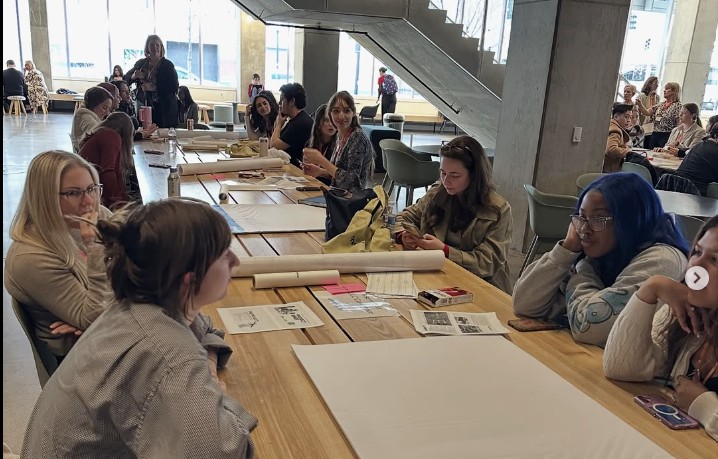
Conference Themes
Informed by conference sessions and interviews with educators from CIDA accredited schools, Tharique De Silva/Assistant Professor of Interior Design at the University of Idaho and Dan Harper/Associate Dean at New York School of Interior Design, we’ve compiled three trends in interior design education that will influence the industry for the next decade.
Defining the Term: CIDA
Council for Interior Design Accreditation (CIDA) is an independent, non-profit accrediting body for interior design education programs in the US and Canada. There are over 170 CIDA-accredited programs with 18,000 enrolled students. CIDA was formerly known as NCIDQ.
Artificial Intelligence and Technology
AI is already a player in design education. Some institutions are actively integrating AI tools into their curriculum while others allow students to explore and experiment. Themes around AI included:
- Enhancing creativity and ideation, with multiple iterations in the design development phases,
- Increasing efficiency by generating 3D visualizations quickly,
- Improving accuracy and transparency by analyzing large data sets.
Educational institutions, like design firms, are exploring ethics and responsible AI use, along with balancing automation and creativity. Examples of how students are integrating AI into their learning include: analyzing research data from various sources, generating/editing project concept statements, assessing concept visualizations and automating repetitive tasks.
AI has become another teaching tool.
– Dan Harper
In addition to AI, many programs, like at College of DuPage (COD), students use Sketch-Up or REVIT with Enscape, an AI enhanced, real-time rendering and VR software plug-in, in their design studios to create virtual models. These “immersive 3D experiences (or models) engage and energize students, enabling them to further refine design concepts, including finish materials and lighting, early in the design process,” explains Shelly Mocchi, Assistant Professor/Program Chair.
Explore an Enscape example created by a COD second-year student here. (Hint: use your phone for the best 3D experience)

Approaching Interiors through an Interdisciplinary Lens
More than just collaborating in studio courses with the architects, today’s interior design students are “interested in diving deep into psychology, sociology and the environmental sciences, exploring how places, spaces and materials affect both the built environment and wellbeing,” (De Silva, 2025).
Students are approaching the design of space as a multisensory, behavioral experience.
– Tharique De Silva
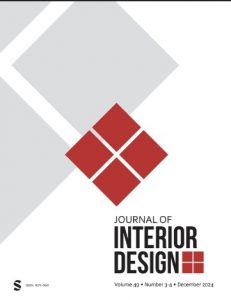
Interdisciplinary studios, labs and electives from across campus, inform today’s interiors education. Designing for social causes / non-profits, supporting local businesses and creating inclusive spaces, interiors students’ experiential learning extends beyond the classroom. At IDEC, conference presentations and panels often focus on multidisciplinary research and projects, collaborating across disciplines, with practitioners and the community. In this space, adjunct faculty contribute real world perspectives and connections in the interdisciplinary design process. Authentic learning takes place in these projects through professional mentors and guided student reflections. Outcomes of these projects are sometimes published in the Journal of Interior Design, JID.
Defining the Term: JID
The Journal of Interior Design (JID) is a scholarly, refereed publication dedicated to an exploration of the interior environment. The Journal seeks to move the discipline forward by welcoming scholarly inquiry from diverse and interdisciplinary approaches, perspectives, and methods that actively explore and analyze the evolving definition of the interior. (Sage, 2025).
More than Sustainability
Wellbeing, regeneration, circularity and resilience are top of mind for today’s interiors students: for their lives and for their work. Gone are the days of the stand-alone Sustainability 101 course freshman year. Instead an integration of sustainable and regenerative principles is incorporated throughout the curriculum. Gen Z, the age cohort of a traditional age college student, are also known as the “sustainability generation,” environmentally conscious and aware of the impact of their choices.
Sustainable thinking is manifest in everything from software for net zero calculations, to carbon neutral finish materials and zero waste construction. Sustainability is so much more than achieving a LEED certification. This expanded perspective of sustainability not only increases student engagement (read “what’s in it for me”) but also prepares students to incorporate this thinking into the core of their practice.
While many presentations integrated sustainable themes into their research, one stand-out example of circularity in action came from Tharique De Silva’s carbon negative furniture grown out of mycelium. His goal is to create furniture that is circular in design, made of eco-friendly, non-toxic materials, locally produced of biodegradable and renewable materials.
This series of images shows the process for De Silva’s “Grown Mycelium + Spalted Maple” chair. Images courtesy of Tharique De Silva.

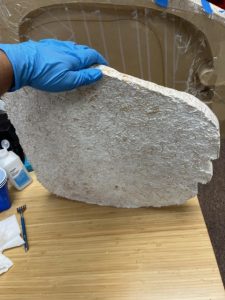
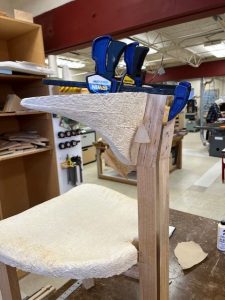

Defining the Term: Mycelium
The root-like structure of a fungus, consisting of a mass of branches and thread like structures. A carbon-negative material, it can absorb more CO2 from the atmosphere than it emits during its lifecycle, (Shah, 2025)
This chair is a departure from traditional methods of construction, challenging designers to think beyond the limitations of their materials.
– Tharique De Silva
Interior Design’s Emerging Role
Themes from the IDEC conference are echoed in the most recent Interior Design magazine 2025 Giants issue. Firms are recruiting for sustainability and materials specialists, VR/AR/AI experts along with workplace strategists, futurists and analysts. “This shift in hiring priorities reflects the growing need for interdisciplinary expertise within the interior design field,” (Interior Design, 2025). With +148,000 interior designers in the US in 2024, the potential growth trajectory is projected to be 4% per year, (IBIS World, 2025).
Designers continue to sit for the NCIDQ exam, 2-4 years after graduation, depending on their degree and work experience. Currently there are over 38,000 certified interior designers in the US and Canada. NCIDQ certification is the first step to becoming certified, registered or licensed within your jurisdiction to practice legally. And NCIDQ certification is a requirement to become a professional member of ASID and IIDA.
Defining the Term: NCIDQ
National Council for Interior Design Qualifications (NCIDQ) is the globally recognized exam for interior design professionals. This certification demonstrates a designer’s proficiency and commitment to the profession.
Creating community is essential for so many interiors students. They want onsite courses and feel like they learn better in person. This current cohort of students were in middle and high school during Covid, learning from home. They are done with online education; they want to belong to a group and work together in their design studio. They intuitively understand that in person work and mentoring will better prepare them for our interdisciplinary interiors practice.
As one of the Columbia College hosts of this year’s conference, Rene King, Assistant Professor of the BFA Interior Architecture Program and former IDEC president knows that programs work hard to keep interiors education current and relevant. Enabling students to share in the conference makes it even more engaging and meaningful.
Interiors students exhibit a unique blend of artistic talent and technical prowess. They care about their classmates and the planet. And they want to do good. We are so inspired by that!
– Rene King
Images courtesy of Cynthia Milota unless otherwise noted.
References
De Silva, T., personal communication, email, April 8, 2025.
Harper, D., personal communication, April 14, 2025.
Interior Design Magazine Staff, (March 2025). Retrieved from: Unveiling Interior Design’s 2025 Top 100 Giants
IBIS World, (2025). Retrieved from: Interior Designers in the US in the US | IBISWorld
King, R., personal communication, April 16, 2025.
Mocchi, S., personal communication, April 16, 2025.
Rajagopal, A., IDEC Speech, March 17, 2025.
Sage Journals, (2021). JID, Retrieved from: Journal overview and metrics: Journal of Interior Design: Sage Journals
Sargent, K., IDEC Speech, March 18, 2025.
Shah, J., (2025). Amazing Architecture, Retrieved from: Mycelium: The Future of Architecture and|Articles
Wikipedia, (2024). Retrieved from: Shearing layers – Wikipedia

